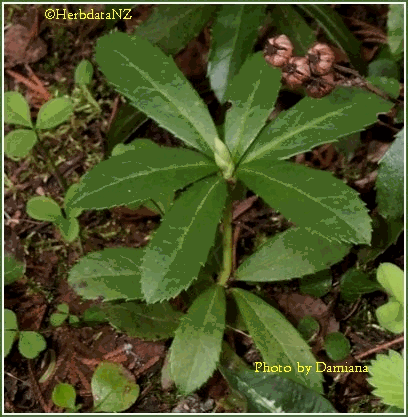
 Pipsissewa:
. U.S.D. 21st 1926
Pipsissewa:
. U.S.D. 21st 1926
Compiled and Edited by Ivor Hughes
CHIMAPHILA. N. F. CHIMAPHILA
Chimaph. Pipsissewa.
Chimaphila consists of the dried leaves of Chimaphila umbellata (Linne) Barton (Fam. Ericacea). Chimaphila contains not more than 5 per cent, of its stems and other foreign organic matter." N. F.
Pipsissewa, Prince's Pine, Wintergreen, Bitter Winter-green, King's Cure, Ground Holly, Love-in-winter, Rheumatism Weed; Herbe de Pyrole ombellee, Fr.; Dolden bluthiges Harnkraut, Wintergrun G.
The name Chimaphila is formed of two Greek words, for, winter, and to love. There are two American species of the genus Chimaphila, only the G. umbellata,however, being official.
This is a low perennial herb, 4 to 10-inches in height, bearing from 4 to 7 flesh-colored pedunculated flowers. The wedge-lanceolate leaves are sharply serrate and borne in irregular whorls, of which there are usually two on the same stem, thick and shiny, not spotted, remaining green through the winter. This plant is common in dry woods from Nova Scotia to Georgia and westward. It is also found in the northern latitudes of Europe and Asia. The drug is collected for the market chiefly in the southern Appalachians and Michigan. The C. maculata (L.) Pursh (Spotted Winter green) differs in having the leaves obtuse at the base and broader than at the summit, remotely toothed and the upper surface of a deep olive green variegated with white.
Description and Physical Properties.
Unground Chimaphila. Oblanceolate, from 2.5 to 7 cm. long and from 8 to
20 mm. wide, the upper portion coarsely and sharply serrate, acute or
somewhat obtuse, the lower wedge-shaped and nearly entire; coriaceous,
smooth and uniformly dark green on the upper surface, paler beneath, the
veins prominent. Odor slight; taste astringent and bitter.
Powdered Chimaphila. Greenish brown; exhibits characteristic epidermal tissue composed of cells with unevenly thickened more or less porous and wavy vertical walls, with outer walls from 0.008 to 0.015 mm. thick; fragments from the lower epidermis with numerous broadly elliptical stomata, the latter up to 0.040 mm. long; fragments of palisade and spongy parenchyma containing chloroplastids; tracheae with spiral or annular markings; a few characteristic, elongated trachea like cells, about 0.014 mm. wide, thick-walled, slightly lignified and with minute double-spiral bands of delicate reticulations; parenchyma cells containing a reddish brown amorphous substance; calcium oxalate in rosettes mostly about 0.035 mm. in diameter, occasionally up to 0.065 mm. in diameter; starch grains few, rounded, simple, up to 0.016 mm. in diameter and sometimes with a central cleft or fissure, or 2- to 4-compound; hairs absent; a few fragments of epidermis from stems and root-stocks, the cells containing a purplish coloring substance which is intensified when the powder is mounted in chloral hydrate T.S. N, F.
Pipsissewa, when fresh and bruised, exhales a peculiar odor. Boiling water extracts the active properties of the plant, which are also imparted to alcohol. Fairbank found in the leaves a peculiar substance which he calls chimaphilin. Chimaphilin was obtained by extracting the tincture with chloroform, or by distilling the stems with water. It occurs in golden-yellow acicular crystals, odorless and tasteless, practically insoluble in water, but dissolving in alcohol, ether, chloroform, and the fixed oils. It is possessed of neither acid nor alkaline properties. Peacock (A. J. P., 1892, p. 295) found that chimaphilin has the chemical composition C24H2104. Ridenour (A.J.P.,1895, 236) confirms this formula. He finds the melting point of the purified chimaphilin to be 114� C. He also prepared another crystalline principle melting above 250� C., to which he gives the formula C10H19O. Arbutin is also found in Chimaphila.
Uses. This plant is stated to have been used internally by the North American Indians in scrofula and rheumatism, and was a popular remedy among the settlers of this country. It has no medicinal properties, however, beyond a feeble diuretic action and perhaps some antiseptic influence on the urine. It is occasionally prescribed for cystitis. The best preparation is the fluidextract, which may readily be made into a syrup.
Dose, thirty to ninety grains (2-6 Gm.).
Off. Prep. Fluidextractum Chimaphilae, N.F.; Fluidextractum Stillingiae Compositum, N.F.; Syrupus Stillingiae Compositus, N.F.
See the NF here .. http://www.herbdatanz.com/nf_usd_f.htm or on the Pharmageddon Herbal CD.
![]()